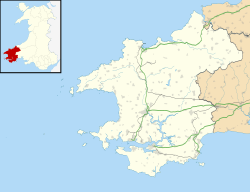Monkton
| |
|---|---|
 Parish church of St Nicholas and St John | |
Location within Pembrokeshire | |
| OS grid reference | SM973015 |
| Principal area | |
| Country | Wales |
| Sovereign state | United Kingdom |
| Police | Dyfed-Powys |
| Fire | Mid and West Wales |
| Ambulance | Welsh |
Monkton is a village and parish [1] adjoining Pembroke, Pembrokeshire, Wales. According to the 2001 census, the population was 1,688.
